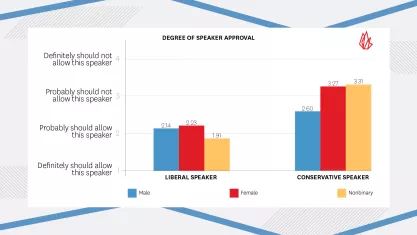Table of Contents
2022 College Free Speech Rankings: Gender differences in censorship attitudes

stock_photo_world / SHUTTERSTOCK.COM
At a recent webinar on this year’s College Free Speech Rankings, we were not able to answer all of the questions from the audience before our time ran out. One of those questions — “Did you find any male/female difference in student attitudes?” — deserves special attention.
The short answer is yes, primarily as it relates to allowing controversial speakers on campus. However, the longer answer becomes more complicated once the attitudes of nonbinary students are considered.
First, the sample for these analyses was taken from this year’s College Free Speech Rankings survey and includes 24,511 female students, 18,922 male students, and 398 nonbinary students. (The remaining students were either agender (136), genderqueer or genderfluid (256), unsure (161) or declined to say (375), and are not included in this analysis. See our methodology for more details.)
Now, when it comes to allowing controversial speakers on campus — our strongest measure of support for censorship in the rankings survey — three patterns emerge in regards to gender:
- Students, regardless of gender, are more likely to oppose allowing a conservative speaker on campus than a liberal one.
- Female students are more censorial than male students, regardless of whether the speaker is liberal or conservative.
- Male students are more censorial toward liberal speakers than are nonbinary students, who are more censorial toward conservative speakers than males are.
The table below demonstrates all of these conclusions.
Table 1: Opposition to Controversial Speakers by Gender
| Speaker | Percentage of female students who oppose speaker | Percentage of male students who oppose speaker | Percentage of nonbinary students who oppose speaker |
| Transgender people have a mental disorder. | 85% | 58% | 82% |
| Black Lives Matter is a hate group. | 85% | 56% | 81% |
| The 2020 Election was stolen. | 77% | 56% | 78% |
| Abortion should be completely illegal. | 72% | 43% | 71% |
| The Second Amendment should be repealed so that guns can be confiscated. | 44% | 38% | 34% |
| Religious liberty is used as an excuse to discriminate against gays and lesbians. | 42% | 33% | 25% |
| Getting rid of inequality is more important than protecting the so-called "right" to free speech. | 35% | 31% | 24% |
| White people are collectively responsible for structural racism and use it to protect their privilege. | 33% | 35% | 14% |
| Undocumented immigrants should be given the right to vote. | 24% | 24% | 12% |
Opposition to speakers espousing conservative views
As the table shows, a greater percentage of students, regardless of their gender, oppose allowing all of the conservative speakers on campus. In fact, when comparing all of the male, female, and non-binary students’ attitudes toward the speakers the support for liberal speakers is rather large and almost always exceeds 20%. For example, while just 56% of males oppose allowing a speaker on campus who promotes the idea that “Black Lives Matter is a hate group,” over 80% of female (85%) and nonbinary (81%) students do.
The only exception is when male students are asked about allowing a speaker who promotes the conservative idea that “abortion should be completely illegal.” Such a speaker is opposed by 43% of males. Three of the liberal speakers (gun control, structural racism, and religious liberty) are also opposed by similar percentages of male students ranging from one-third to 38%.
Gender differences in censorship
The survey data also suggests that female students tend to be more censorial than males. Of the nine speakers, only two of them would be allowed by a larger percentage of females than males.
In one such case, 35% of male students oppose allowing someone who promotes the idea that “White people are collectively responsible for structural racism and use it to protect their privilege,” compared to 33% of females.
Female students and nonbinary students are significantly more censorial toward conservative speakers than are male students.
In the other, an equal percentage of male and female students (24%) oppose allowing a speaker on campus who promotes the idea that “undocumented immigrants should be given the right to vote.”
The existence of a censorship gap between male and female students is also consistent with a good deal of scholarship in communication, political/social psychology, and political science. Compared to men, women are more likely to support the censorship of offensive, sexual, or violent material. Men, in contrast, are more likely to consider free speech important and less likely to consider hate speech harmful.
Are nonbinary students less likely to censor?
Although nonbinary students mirror female students in their opposition to allowing conservative speakers on campus, they are also less censorial toward liberal speakers than are male students. Among nonbinary students, opposition to allowing the four conservative speakers on campus ranged from 71% to 82%. In contrast, opposition to the five liberal speakers ranged from 12% to 34%.
Among male students, however, opposition to the conservative speakers ranged from 43% to 58%, while opposition to the liberal speakers ranged from 24% to 38%.
All students are more censorial toward conservative speakers than liberal speakers.
Finally, when computing and comparing composite scores, ranging from one (definitely should allow the speaker on campus) to four (definitely should not allow the speaker on campus), measuring average intolerance of the five liberal and the four conservative speakers, the following results (albeit unweighted) emerge from a one-way Analysis of Variance (ANOVA) and subsequent pairwise comparisons, further reinforcing the three points made above:
- Female students and nonbinary students are significantly more censorial toward conservative speakers than are male students. Female students and nonbinary students do not differ significantly.
- Male students and female students are significantly more censorial toward liberal speakers than are nonbinary students.
- Female students are significantly more censorial toward liberal speakers than are male students.

In sum, all students are more censorial toward conservative speakers than liberal speakers; female students are more censorial than males, regardless of the speaker’s ideology; and nonbinary students are only highly censorial toward conservative speakers.
When considering this censorship gap between males and females along with data indicating that the percentage of women now outpaces men at all levels of academia — undergraduate, graduate, faculty — over the past few decades, these findings suggest that academia will become more supportive of restricting expression.
Recent Articles
Get the latest free speech news and analysis from FIRE.

FIRE's 2025 impact in court, on campus, and in our culture

The trouble with banning Fizz

VICTORY: Court vindicates professor investigated for parodying university’s ‘land acknowledgment’ on syllabus


